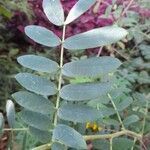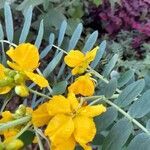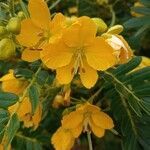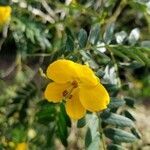Dense, rounded shrub or tree to 5 m tall. Stems, rachises, inflorescences, and leaves densely yellow-or white-tomentose. Leaves 5-16 cm long, petiole 0.2-1.2 cm long, the rachis bearing a pyriform or conic nectary between the proximal and sometimes more distal pairs of leaflets; leaflets 5-8 pairs, increasing in size distally on the rachis, oblong, the terminal leaflets 2-4 cm long x 0.5-1.2 cm wide, apex rounded-mucronate, base asymmetrical, margins revolute, midvein deeply impressed on the upper surface. Inflorescence of axillary corymbiform racemes 3-10 cm long, usually somewhat exserted above the foliage, flowers 3-8 per raceme; sepals oblong to obovate, unequal, abaxially tomentose; petals obovate, 1-1.5 cm long, glabrous; fertile stamens 7, with 3 long abaxial and 4 short median stamens, the anthers obliquely truncate and dehiscent by 2 confluent terminal pores; ovary densely golden-tomentose, style glabrous, stigma minutely porate. Fruits pendulous, linear-oblong, terete or somewhat laterally compressed, 6-12 cm long x 0.6-1 cm across; valves papery, light brown, finely pubescent, ± corrugated over the seeds, edged with wide, flattened sutural ridges, internally septate and somewhat pulpy; seeds in one row, ovate, brown, glossy, lacking an areole.
Shrub or small tree, erect, to 4 m tall, pubescent on leaves, inflorescence, sepals and ovary, otherwise glabrous or glabrescent. Leaves 6-8 cm long including a terete petiole 8-12 mm long; stipules acicular, caducous; leaflets in 6-8 pairs spaced 8-12 mm apart, lanceolate to oblong, 20-30 mm long, 8-12 mm wide, increasing distally, recurved at the margins, acute and mucronate; glands 2-4, between the lowest leaflet pairs, erect, pointed. Inflorescence of 10-20 flowers, terminal and in upper axils; peduncle 20-30 mm long; pedicels 10-12 mm long; bracts caducous. Petals 10-20 mm long. Fertile stamens 7, with 3 adaxial staminodes; fertile filaments distinctly unequal, 4-8 mm long; fertile anthers distinctly unequal, 4-7 mm long, the largest with a single U-shaped pore. Pod compressed-cylindric, 6-8 cm long, c. 8 mm diam., slightly curved, entire. Seeds dull.
Shrub or small tree to 6 m high, not armed; twigs densely hairy, finely ribbed, rounded. Lvs 1-paripinnate, densely hairy on rachis, petiolate; leaflets moderately hairy above, moderately or densely hairy below, oblong or elliptic, slightly asymmetric, subacute and shortly mucronate, entire, subsessile, (10)-15-40 mm long, usually in (4)-5-8 pairs; protruding glands mostly present between each pair of leaflets, often small or deciduous; stipules deciduous. Infl. axillary, racemose, few-flowered, < or ± = lvs; bracts and bracteoles narrow-ovate, deciduous, 3-6 mm long. Calyx teeth unequal, acute or subacute. Corolla deep golden yellow, c. 2 cm long; stamens 7; staminodes 3. Pod indehiscent, hairy, ± straight or slightly curved, terete or slightly flattened, many-seeded, 8-12 cm long; seeds smooth, brown, c. 5 mm long.
Dense, rounded shrub or tree, up to 5 m high; stem, rachises, inflorescences and leaves densely yellow-or white-tomentose. Leaves 50-160 mm long. Leaflets 5 to 8 pairs, oblong, base asymmetrical, apex rounded to mucronate, increasing in size distally. Inflorescences of axillary corymbose racemes, somewhat exserted above foliage. Flowers 3-8 per raceme, deep yellow to brown-veined with age. Flowering time July-May. Pod pendulous, linear to oblong, terete or somewhat laterally compressed, 60-120 x 6-10 mm. Valves papery, light brown, finely pubescent, corrugated over seeds, internally septate and pulpy. Seeds one row, laterally ovate, brown, glossy, lacking areole.
Shrub, up to 4 m high. Stems woody. Leaves discolorous; (30-)90-120 mm long; rachis glandular with a sessile, cylindric, finger-like, acuminate, dark gland; stipules linear, densely pubescent and caducous. Flowers: inflorescences distal pseudo-panicles, in axils of upper leaves, 37-70 mm long; corolla deep yellow; May. Pods linear to slightly curved, 70-110 mm long, compressed; seeds many, compressed against each other along length of pod.
Perennial shrub, up to 4 m high. Young stem apices and abaxial leaflet surfaces cano-tomentose. Flowers deep yellow.
A shrub.






